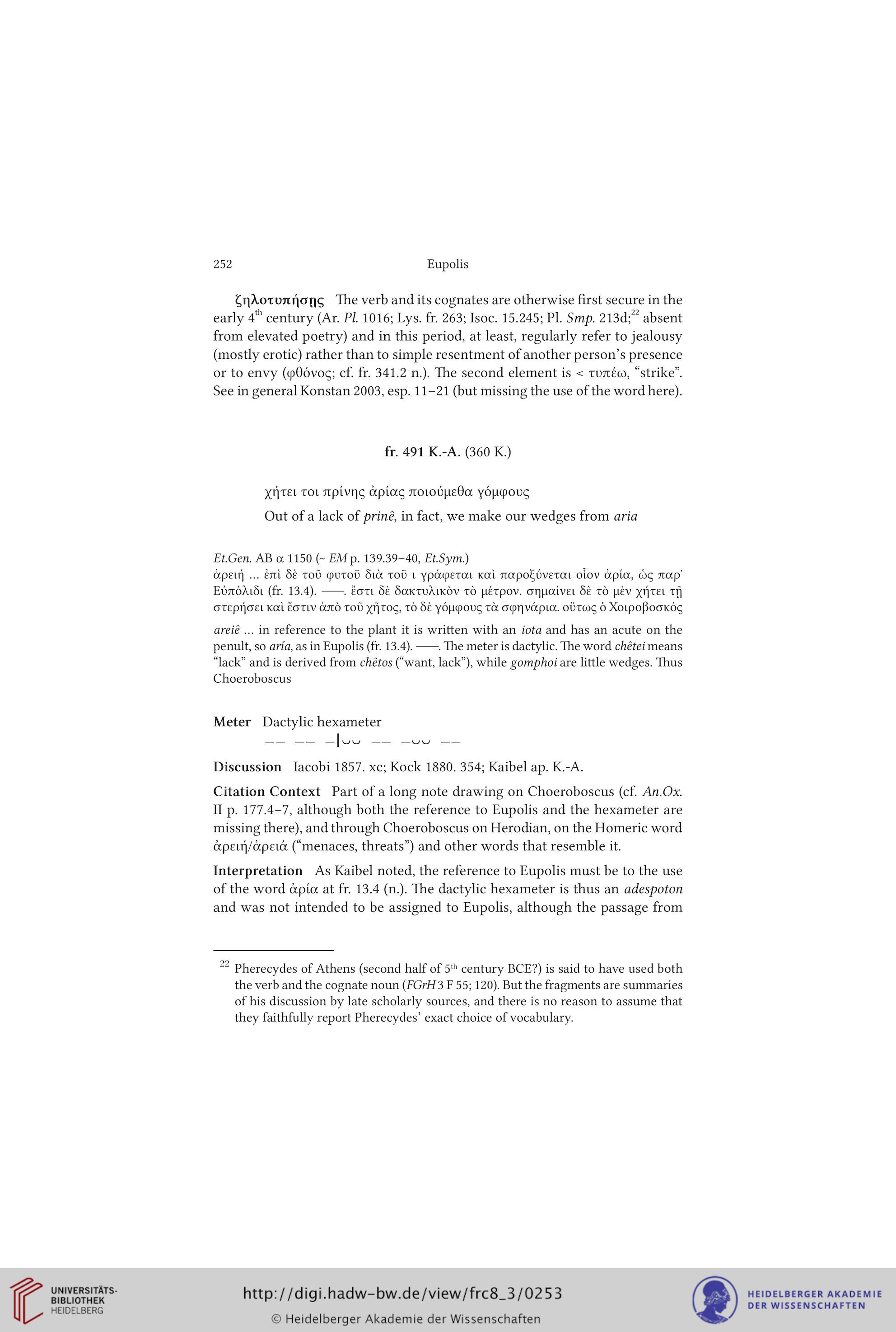252
Eupolis
ζηλοτυπήσης The verb and its cognates are otherwise first secure in the
early 4th century (Ar. Pl. 1016; Lys. fr. 263; Isoc. 15.245; Pl. Smp. 213d;22 absent
from elevated poetry) and in this period, at least, regularly refer to jealousy
(mostly erotic) rather than to simple resentment of another person’s presence
or to envy (φθόνος; cf. fr. 341.2 n.). The second element is < τυπέω, “strike”.
See in general Konstan 2003, esp. 11-21 (but missing the use of the word here).
fr. 491 K.-A. (360 K.)
χήτει τοι πρίνης άριας ποιούμεθα γόμφους
Out of a lack of prine, in fact, we make our wedges from aria
Et.Gen. AB a 1150 (~ EMp. 139.39-40, Et.Sym.)
άρειή ... έπί δέ τοΰ φυτού διά τού ι γράφεται καί παροξύνεται οίον άρια, ώς παρ’
Εύπόλιδι (fr. 13.4).-. έστι δέ δακτυλικόν τό μέτρον. σημαίνει δέ τό μέν χήτει τή
στερήσει καί έστιν άπό τού χήτος, τό δέ γόμφους τά σφηνάρια. ούτως ό Χοιροβοσκός
areie ... in reference to the plant it is written with an iota and has an acute on the
penult, so aria, as in Eupolis (fr. 13.4).-. The meter is dactylic. The word chetei means
“lack” and is derived from chetos (“want, lack”), while gomphoi are little wedges. Thus
Choeroboscus
Meter Dactylic hexameter
Discussion lacobi 1857. xc; Kock 1880. 354; Kaibel ap. K.-A.
Citation Context Part of a long note drawing on Choeroboscus (cf. An.Ox.
II p. 177.4-7, although both the reference to Eupolis and the hexameter are
missing there), and through Choeroboscus on Herodian, on the Homeric word
άρειή/άρειά (“menaces, threats”) and other words that resemble it.
Interpretation As Kaibel noted, the reference to Eupolis must be to the use
of the word άρια at fr. 13.4 (n.). The dactylic hexameter is thus an adespoton
and was not intended to be assigned to Eupolis, although the passage from
22 Pherecydes of Athens (second half of 5th century BCE?) is said to have used both
the verb and the cognate noun (FGrH3 F 55; 120). But the fragments are summaries
of his discussion by late scholarly sources, and there is no reason to assume that
they faithfully report Pherecydes’ exact choice of vocabulary.
Eupolis
ζηλοτυπήσης The verb and its cognates are otherwise first secure in the
early 4th century (Ar. Pl. 1016; Lys. fr. 263; Isoc. 15.245; Pl. Smp. 213d;22 absent
from elevated poetry) and in this period, at least, regularly refer to jealousy
(mostly erotic) rather than to simple resentment of another person’s presence
or to envy (φθόνος; cf. fr. 341.2 n.). The second element is < τυπέω, “strike”.
See in general Konstan 2003, esp. 11-21 (but missing the use of the word here).
fr. 491 K.-A. (360 K.)
χήτει τοι πρίνης άριας ποιούμεθα γόμφους
Out of a lack of prine, in fact, we make our wedges from aria
Et.Gen. AB a 1150 (~ EMp. 139.39-40, Et.Sym.)
άρειή ... έπί δέ τοΰ φυτού διά τού ι γράφεται καί παροξύνεται οίον άρια, ώς παρ’
Εύπόλιδι (fr. 13.4).-. έστι δέ δακτυλικόν τό μέτρον. σημαίνει δέ τό μέν χήτει τή
στερήσει καί έστιν άπό τού χήτος, τό δέ γόμφους τά σφηνάρια. ούτως ό Χοιροβοσκός
areie ... in reference to the plant it is written with an iota and has an acute on the
penult, so aria, as in Eupolis (fr. 13.4).-. The meter is dactylic. The word chetei means
“lack” and is derived from chetos (“want, lack”), while gomphoi are little wedges. Thus
Choeroboscus
Meter Dactylic hexameter
Discussion lacobi 1857. xc; Kock 1880. 354; Kaibel ap. K.-A.
Citation Context Part of a long note drawing on Choeroboscus (cf. An.Ox.
II p. 177.4-7, although both the reference to Eupolis and the hexameter are
missing there), and through Choeroboscus on Herodian, on the Homeric word
άρειή/άρειά (“menaces, threats”) and other words that resemble it.
Interpretation As Kaibel noted, the reference to Eupolis must be to the use
of the word άρια at fr. 13.4 (n.). The dactylic hexameter is thus an adespoton
and was not intended to be assigned to Eupolis, although the passage from
22 Pherecydes of Athens (second half of 5th century BCE?) is said to have used both
the verb and the cognate noun (FGrH3 F 55; 120). But the fragments are summaries
of his discussion by late scholarly sources, and there is no reason to assume that
they faithfully report Pherecydes’ exact choice of vocabulary.




